
of st. joseph of peace autumn 2023
New Times Demand a Change of Heart Living peace congregation of the sisters
The mission of Living Peace, a free occasional publication of the Congregation of the Sisters of St. Joseph of Peace is to build community with a diverse audience by engaging our readers in contemplation and action for justice and peace through informative and reflective articles, poetry and prayers.
If you wish to change your address, or if you or someone you know would like to be added to our Living Peace mailing list, please contact Cristina Turino at cturino@csjp.org or 201-608-5401.
Copyright: Articles in Living Peace may be reprinted. Please include the following on reprints: “Reprinted with permission from the Sisters of St. Joseph of Peace, 399 Hudson Terrace, Englewood Cliffs, NJ 07632, www.csjp.org” Please send us a copy of the reprinted article.
Jan Linley, Editor
Susan Francois, CSJP, Leadership Team Liaison
Cristina Turino, Editorial Assistant and Distribution Manager
Contributing Writers
Frank McCann, CSJP-A
Stephanie Peirolo, CSJP-A
Cover Art:
Matthew Prindle illuminates love, joy, and creativity, courageously guided by his inspired heart. As an entrepreneur, craftsman, adventurer, and artist, he has built a life of purpose and exploration. Living in a tiny house he built Matthew founded “Basecamp,” an intentional living community in Portland, OR. Through his venture, Intention Inspired, he aids individuals in unearthing their deepest intentions and motivates aligned action. Matthew’s adventurous essence propels him into nature’s embrace, enjoying backpacking, skiing, surfing, climbing, and beyond. He is committed to self-love while creating beautiful spaces and experiences that promote collective healing, connection, and joy, reflecting his profound respect for life.
He created the art on the cover for his “30 Days of Bravery” journey for Intention Inspired, for the session on being committed to our brave goal. You can find more at www.intentioninspired.com

Design
Beth Ponticello, CEDC, www.cedc.org
in this issue
Jan Linley
Andrea Nenzel, CSJP
JV Valladolid
Melody Maravillas, Congregation Chief Financial Officer
Bryan Johns, CSJP-A
By Stephanie Peirolo, CSJP-A
Susan Francois, CSJP
Living peace autumn 2023 3 Message from Congregation Leadership: Invitation to Transforming Grace by
4 From the Editor: Ingredients for a Change of Heart by
5 Prayer by
6 The Overburdened Ironbound Provides Hope and Beauty by
8 Fresh Voices: Interested in Intersections and Inspired by Love of Their City by
10 All Are Welcome But…
12 The Refugee by
14 Pause 16 FrankTalk: Can We Grow in Awe and Wonder? by Frank McCann, CSJP-A 18 Peace Ministries: Responding to the Signs of This Time by
Just Work
History and Roots: Stick to Your Colours by
Kathleen Pruitt, CSJP, Congregation Leadership Team
Rachel Dawn Davis
By
Kelly Marsicano 20
22
Invitation to Transforming Grace
by Kathleen Pruitt, CSJP
The following piece of evocative wisdom was shared by a friend who happens to be my Zen teacher. It echoes what we are invited to reflect on by so many of the spiritual guides, teachers, companions, great sages, and saints. Sometimes hearing the same message in another way is helpful in prompting deeper reflection on things we already know somewhere deep within.
People everywhere try so hard to make the world better. Their intentions are admirable, yet they seek to change everything but themselves. To make yourself a better person is to make the world a better place. Who develops industries that fill the air and water with toxic waste? How did we humans become immune to the plight of refugees, or hardened to the suffering of animals raised to be slaughtered? Until we transform ourselves, we are like mobs of angry people screaming for peace. In order to move the world, we must be able to stand still in it. Now more than ever, I place my faith in Gandhi’s approach: Be the change you wish to see in the world. Nothing is more essential for the twenty-first century and beyond than personal transformation. It’s our only hope. Transforming ourselves is transforming the world. (Yongey Mingyur Rinpoche)
We are familiar with biblical passages like Love your neighbor as you love yourself; Do unto others as you would have done to you; We are our sisters’ and brothers’ keepers; and What I do to another I do to myself. These and many others are invitations to look deeply and listen attentively, invitations to be open to transforming grace. To allow ourselves to be moved—transformed even—Mingyur Rinpoche’s words remind us again that time in meditation is a time for standing still. It is a time for listening with the ear of the heart, a time for opening to the transforming presence of a Mystery of Love within, a Mystery closer to us than we are to ourselves, a Mystery we cannot comprehend but can trust is transforming. Jesus knew this, so did the Buddha, so did the saints and sages of all times whose lives and living offer us pathways to the deepest longings of our very being. And the restless longings of our own hearts tell us that we, too, know this.
May the words offered by so many be a gentle catalyst for each of us to look deeply into ourselves and see if there is anything, no matter how small, that we long to do to be ever more open to the great Mystery closer to us than we are to ourselves. Are we holding back in any way from being the change we wish to see in the world? Can we be thankful for the opportunity, the freedom, to stand still in it and so help transform our wonderful, wounded world?
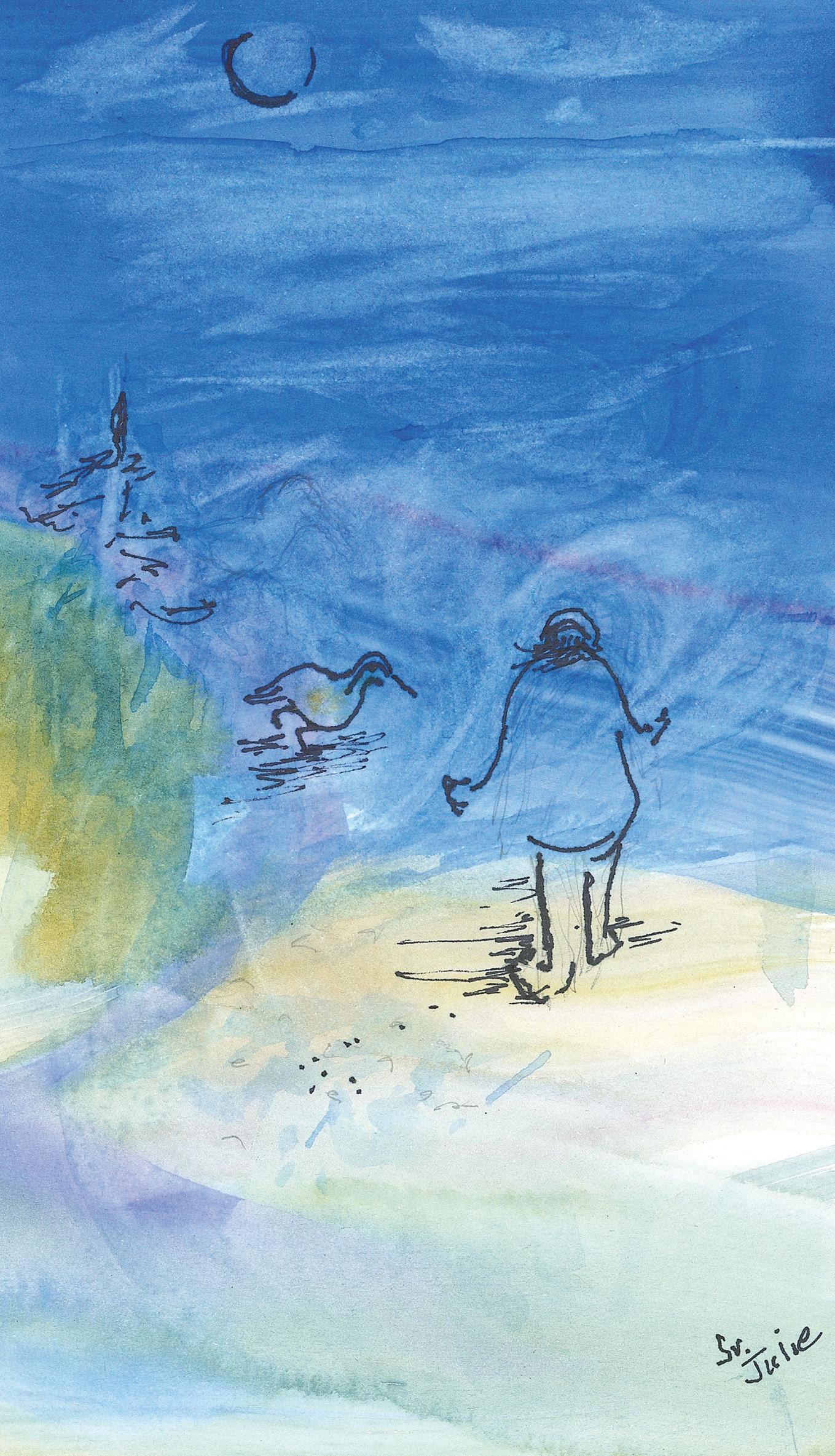
AUTUMN 2023 3
FROM
MESSAGE
CONGREGATION LEADERSHIP
Watercolor by Julie Codd, CSJP
FROM THE EDITOR
Ingredients for a Change of Heart
by Jan Linley
From our thought-provoking cover art by Matthew Prindle to the challenging yet hope-filled articles in this issue of Living Peace, we continue to unpack the Congregation’s Chapter Call, “To Be Who We Say We Are.” Contributors were asked to focus on one or all the following key phrases:
• These new times demand a change of heart: to be, think, and act differently.
• Addressing, healing, and being present to the wounds and broken relationships among ourselves and all God’s creation.
• Making a place for everyone at the table where all are welcomed and all gifts are honored. The radical change of heart that the Chapter Call demands requires both faith and commitment. Anyone who has ever broken a bad habit, overcome an addiction, or made other significant lifestyle changes has learned the power of commitment and that true transformation requires re-committing on a daily, sometimes hourly, basis. Commitment goes hand in hand with active faith.
Solastalgia is a term used to describe the feeling of grief caused by the disconnection to our natural world and witnessing the depletion of the earth’s resources. In talking about the environment and solastalgia, Dr. Sabrina Helm says we are prone to forming psychological distances that prevent us from making necessary changes. We tell ourselves the places impacted by climate crisis are so far from our lived experience, it doesn’t affect us, or we think we will not be around when it gets really bad, so it doesn’t matter on a personal level.
Helm’s suggestion about forming psychological distances could be applied to a host of integrated crises: the global pandemic, racism, war and violence, the mass migration of people, political polarization, and environmental destruction. A change of heart demands recognizing our part in these crises. It is not a blame game but both necessary and empowering to look at these urgent challenges head-on and listen to the voices of hope and guidance that can steer us toward profound change.
Melody Maravillas writes, “Being who we say we are also evokes a restlessness, a challenge if you will, to constantly assess ourselves for areas where we fall short.” She reminds us that transformation also requires continuous scrutiny and action.
In a dreamy, almost other-worldly article, Bryan Johns forces us to ponder why we all cannot see one another when each of us is made in Love. Like Melody, he asks us to question why we are not all welcomed unconditionally.
Waterspirit’s Rachel Dawn Davis and Ironbound Community’s JV know that transformation is a long game, but that doesn’t make them apathetic or any less hopeful. To the contrary, they are spurred to action by what needs to be done and inspired by the successes of those who have gone before them. We hope their passion is contagious.
Frank McCann writes about the profound transformation required in developing an ecological spirituality that recognizes the interconnectedness of all creation and of all the crises we currently face. Frank suggests we become more aware of the ongoing miracles that surround us.
Stephanie Peirolo examines her own change of heart regarding participating in a system that favors owners and shareholders over workers and their welfare. She invites us to look at work through a social justice lens.
Kelly Marsicano, Communications Coordinator for Peace Ministries, sat down with Executive Director Maureen Donohue to get her thoughts on this new era we find ourselves in and to learn how Peace Ministries is responding in new ways and hoping to have the courage to follow the promptings of the Spirit as they respond to the signs of this time.
Quoting her Zen teacher, Sister Kathleen Pruitt writes, “In order to move the world, we must be able to stand still in it.” While Sister Andrea Nenzel tells us it’s okay if prayer is a whole-body experience that sometimes includes anger or dancing for joy.
One of the Congregation’s founders, Mother Evangelista, knew the value of deep roots and the necessity of nourishing them on a regular basis. Sister Susan Francois’ History and Roots article makes clear this call, “To Be Who We Say We Are” was seeded in the very early days of the Congregation.
The other essential ingredient to a change of heart is desire; sheer will is not enough, but if we want it badly enough, we can do it person by person, commitment by commitment, and action by action. In these pages we hope you find something that stirs or quells your spirit, fills you with hope and ignites or fuels a change of heart.
4 LIVING PEACE
Prayer
Prayer is talking with God. Listening. Dancing for joy. Sharing presence with God. Screaming in anguish. Prayer happens in sacred spaces, at home, in nature, anywhere, anytime. Prayer can be shared with those of my faith, and prayer can be shared across denominational and faith lines because there is but one God and we are all sisters and brothers. How my understanding of prayer has changed during my life! In my early years I talked, saying prayers and sharing concerns and wants with God. I remember my sisters and I kneeling at our bedsides saying our night prayers and putting in our list of needs and hopes. We said morning prayers and evening prayers as a family.
Gradually I learned to listen - to wait in silent expectation. I remember my dad teaching me to listen to the grass grow so that he could have meditation time in the early mornings while working out in the garden. There in the garden I learned to listen to nature and to hear God.
I remember too the evening that I learned the secret of loving presence - the deep awareness of being present with a beloved. I was 14, doing my homework in the kitchen while my mother was ironing in the corner and my dad was at the counter
 by Andrea Nenzel, CSJP
by Andrea Nenzel, CSJP
doing paperwork. I became aware of the stillness - peaceful yet alive. Later I asked my mother about it. I can still hear her response, “For those who love deeply just being present to each other can speak volumes.”
Later I learned that anger and pain belong in prayer. I remember attending a play in New York in the early 1980s at the start of the HIV/AIDS era. A young man’s partner has just died of AIDS. He goes onto the rooftop and screams his anguish to God. I recall so vividly being shocked by the realization that this was the most authentic prayer I had experienced. The whole person was praying.
And then there is the whole-person prayer of joy and wonderment. I watched with delight the dance of profound gratitude and exhilarating joy of a friend upon the birth of his daughter. Could anyone doubt what he was feeling and conveying with his whole person?
Today I realize that my life enfolds all these aspects of prayer. Prayer is communing with God with my whole being. What really matters is that I allow God to love me and that I be authentically me in receiving and sharing the love.
AUTUMN 2023 5
The Overburdened Ironbound Provides Hope and Beauty
by Rachel Dawn Davis, Public Policy & Justice Organizer for Waterspirit
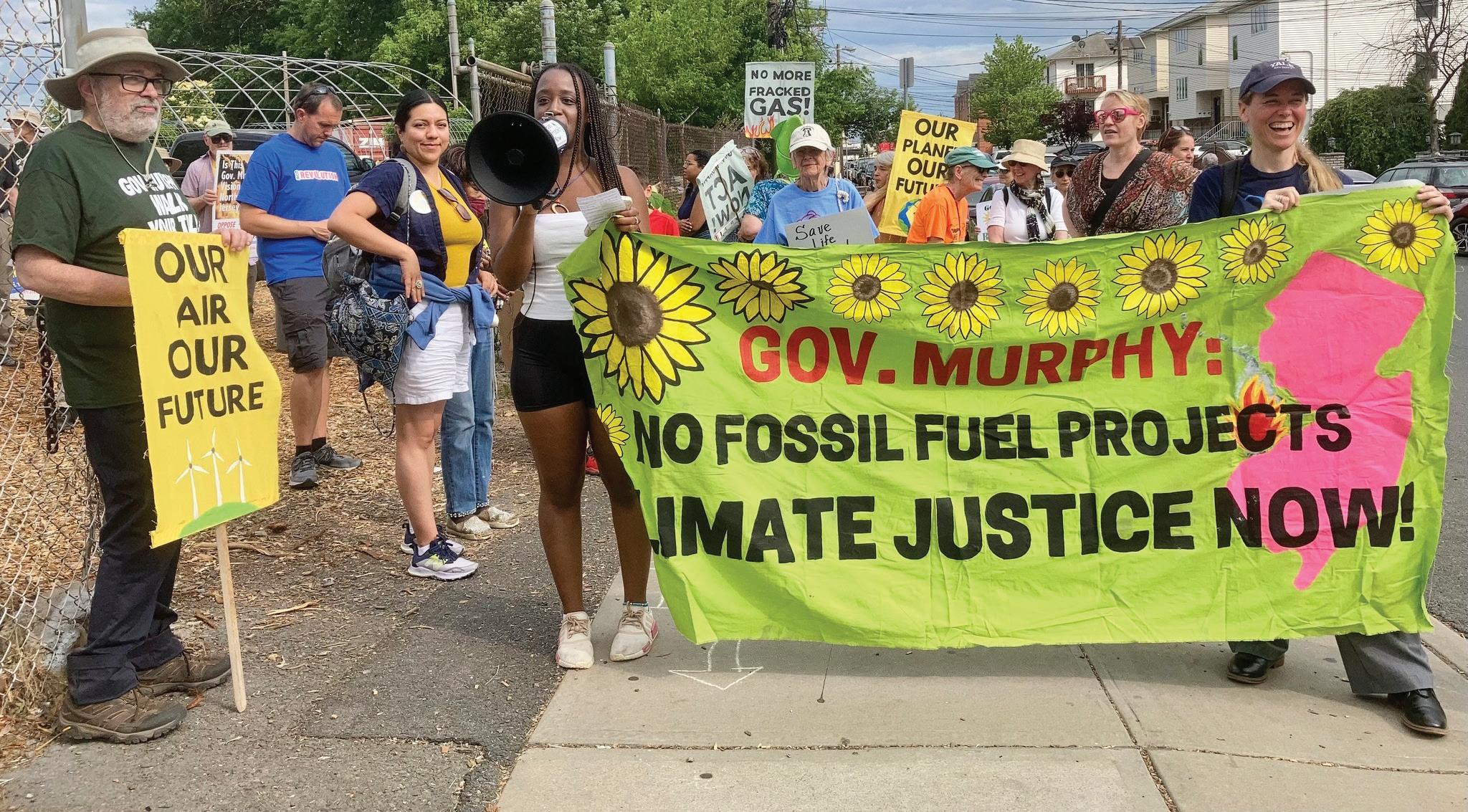
Waterspirit is a spiritual ecology nonprofit inspired by the beauty of the Jersey Shore. Earlier this year, a gathering of supporters celebrated 25 years of Waterspirit with our annual Joys of the Sea gala, which took place in the Oak Grove outside the First Presbyterian Church of Rumson, New Jersey. We created signage for the surrounding natural elements—trees, shrubs, and birds—which prompted attendees to ponder: “What would it be like if everyone had access to shade cover and nature immersion?” We envision a world where water, trees, and food are sufficient for everyone. It is our hope that shared activism can push such visions into reality.
Waterspirit has been working in coalition with front and fence line leaders, residents, health experts, and climate justice advocates to raise the bar on environmental leadership by preventing pollution-laden projects from moving forward and by advocating for enduring legal protections. In 2020, after New Jersey passed the strongest environmental justice law in the nation, Waterspirit provided ample commentary to support the ensuing rulemaking process, which provides the guidelines for how the law should be enacted. We highlighted the need to access healthcare facilities and services, the cost burden on care related to preventable pollution, and the ongoing emotional
and mental distress that results from pollution in overburdened communities. Although it is yet to be enforced, the environmental justice law remains an opportunity for decision-makers to prevent pollution and to work with community members to forge viable, sustainable solutions.
Intentional organizing to prevent pollution requires a deep connection with residents of an area of most concern, particularly in overburdened communities already facing environmental injustices. Last year, our Suzanne Golas Spirit of Water Award recipient was Maria Lopez-Nuñez, an environmental justice leader based in Newark who works as Deputy Director of Organizing and Advocacy for the Ironbound Community Corporation (ICC). “ICC builds community by investing in children’s future and organizing for justice.” The large role Maria plays in activating and uplifting the community of Newark (and the broader world) remains humbling to all who are engaged in social justice advocacy work. We are careful to follow the lead of Maria and the ICC when we support campaigns in the Ironbound, understanding them to be the experts on what is best for their community. Waterspirit is dedicated to good allyship in order to undo a history of environmental groups engaging in saviorship or paternalism in their relationship with frontline environments.
6 LIVING PEACE
March rally in the Ironbound, holding banner, Chloe Desire, ICC on left and Blair Nelsen of Waterspirit on right.
In Newark, the intergenerational experience of traumatic pollution-related disease continues to run rampant. By securing media coverage of residents and public health experts, and by translating outreach materials into Portuguese, given the large Portuguese speaking community in the Ironbound, Waterspirit has provided strategic support to prevent further pollution in the Ironbound. We helped generate turnout that ultimately resulted in the prevention of one sludge processing facility. It is important to celebrate wins or advancements, however small, to ensure we realize our actions have influence. People matter and the importance of putting faces to public health experiences cannot be overstated.
Bearing witness and being actively present to the ongoing onslaught of outside polluters dumping on Newark with seemingly no end in sight, Waterspirit is addressing the wounded relationships among each other and all Creation. Greed does not go away without a fight, and the need to clearly communicate the potential for pollution prevention across languages is still pressing. During one visit earlier this year, Waterspirit staff counted trucks to gather data demonstrating an excess of commercial traffic in a residential area. Planes flying low overhead, commercial trucks chugging through residential neighborhoods, foul smells from the incinerators— from every corner, we saw rules being broken and laws against pollution going unenforced.
For the past three years, Waterspirit has been speaking out about the preventable methane
emitting gas plant proposed by Passaic Valley Sewerage Commission (PVSC) to avert wastewater overflows. While the Federal Emergency Management Agency (FEMA) cites that dirty gas backup power is not to be relied upon in the event of a flood emergency, the project—which would do exactly what FEMA recommends they shouldn’t— remains proposed even alongside potential 100% renewable energy alternative scenarios. We must continue to put pressure on decision-makers to stop the next phases of the project, which would include an air permit approval by the New Jersey Department of Environmental Protection (NJDEP). This remains our charge today and Waterspirit is building broader support to enliven urgent action. Even though these pollution-fighting campaigns can take years, it is important to keep hope alive. Last month, Waterspirit and coalition partners gathered in Newark to raise awareness about the need to prevent the PVSC’s dirty gas project. An 85-yearold resident, Pastor Gloria Swieringa of Newark, lent her vocal stylings to the rally, demonstrating how crucial it is to offer spiritual strength. She was raised in Newark and remarked on how beautiful it is to experience the riverfront park; something that was a far cry from existing when she was growing up. The Ironbound is an overburdened area and a source of beauty and hope for all. We are honored to put our spiritual commitments to hear the cry of the Earth and the cry of her most vulnerable people into action through being good allies to this frontline community.
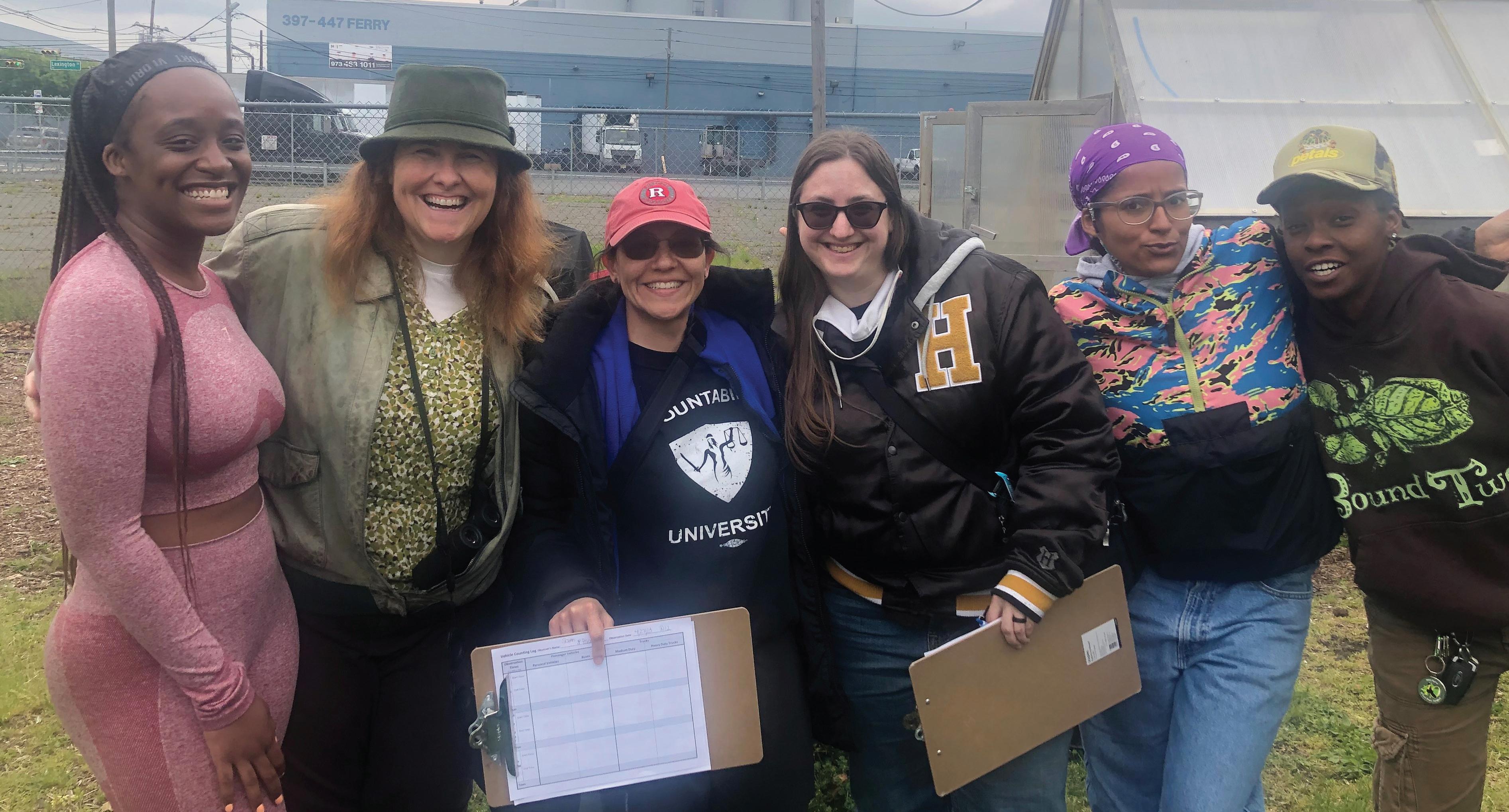
AUTUMN 2023 7
Ironbound and Waterspirit join forces at a truck count. From Left to Right: Chloe Desir, Anne Price, Rachel Dawn Davis, truck count volunteer, Down Bottom Farms staff
Fresh Voices Recognizing the Intersections, Inspired by Love of Their City
by JV Valladolid
Most of the articles in Living Peace are written by sisters, associates, or staff. Fresh Voices is a column written by, or focusing on, someone outside the CSJP community to help raise awareness on specific issues.

Meet JV, 33 years-old, born and raised in Newark, they have been working for the Ironbound Community Corporation (ICC) for close to 10 years, first as a volunteer in direct family services and for the last two years as a Frontline Communications Manager for environmental justice. JV shared with us what drew them to this work, why they are passionate about it, and how they keep that passion alive.
My background is in reproductive justice and sexuality education in Newark and throughout New York City for adults and persons with intellectual and/or developmental disabilities. I went to the Family Success Center at ICC as a volunteer. As a first-generation child of immigrants, in a community that is primarily Spanish and Portuguese speaking, I thought it was amazing that ICC was offering services for free. Then I learned more about environmental justice through my proximity to it and really liked it. I’m interested in the intersection of social issues and environmental justice. I continue to volunteer with the sexuality education organization Masakhane Center in Newark, and that’s one of the things I find important to share with people who are joining us to become educators. There is research published about heat island effects on pregnant people. Just living in a place that has less green space and is literally hotter than other places can impact pregnancy outcomes. In Newark we have a long history of several decades of facilities that have targeted the city and have left pollution as their legacy.
One of the biggest campaigns that was just starting when I came in two years ago is a proposal for a fourth fossil fuel power plant in Newark. The community is only four-square miles. This is something that has been proposed by the largest sewage wastewater processing facility on the East Coast, which also happens to be in Newark, Passaic Valley Sewerage Commission. They service dozens of other municipalities outside of Newark, but they have open pits of sewage. It looks like swimming pools full of human waste, and that contributes to the smell in the community. And New Jersey has this stereotype of New Jersey smells. And it’s true, and unfortunately our community gets different terrible smells that are not just unpleasant, but sometimes it means that students don’t go outside during recess or people are shutting their windows or getting headaches or feeling nauseous throughout the day.
8 LIVING PEACE
Over 30 years ago we received the largest garbage incinerator in the state of New Jersey, and we had the discovery of Agent Orange in over 17 miles of the Passaic River that runs alongside many communities. Agent Orange was being manufactured in Newark, right in the Ironbound neighborhood, which is the neighborhood that we focus the most on because of its proximity to the facilities and that heavy industrial zoning. Once the facility shut down, all those byproducts stayed. So, the cleanup effort has been decades long, because a lot of these chemicals linked to cancer, including dioxin, don’t mix with water. Plus, there are three existing fossil fuel power plants, over 100 brownfield sites, and limited green space. There are so many things that are really stacked up against the community in terms of public health issues. The work that our team focuses on is how we can inform policy, not just for Newark but for communities that look very much like ours throughout the country.
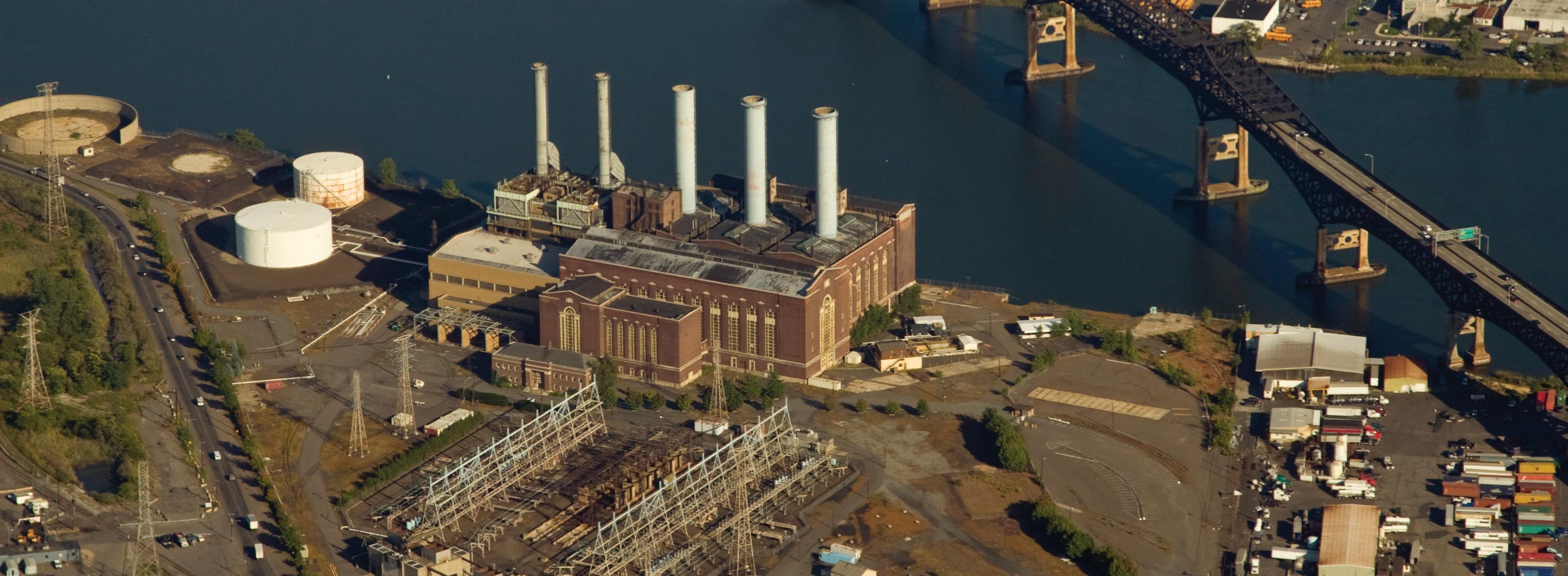
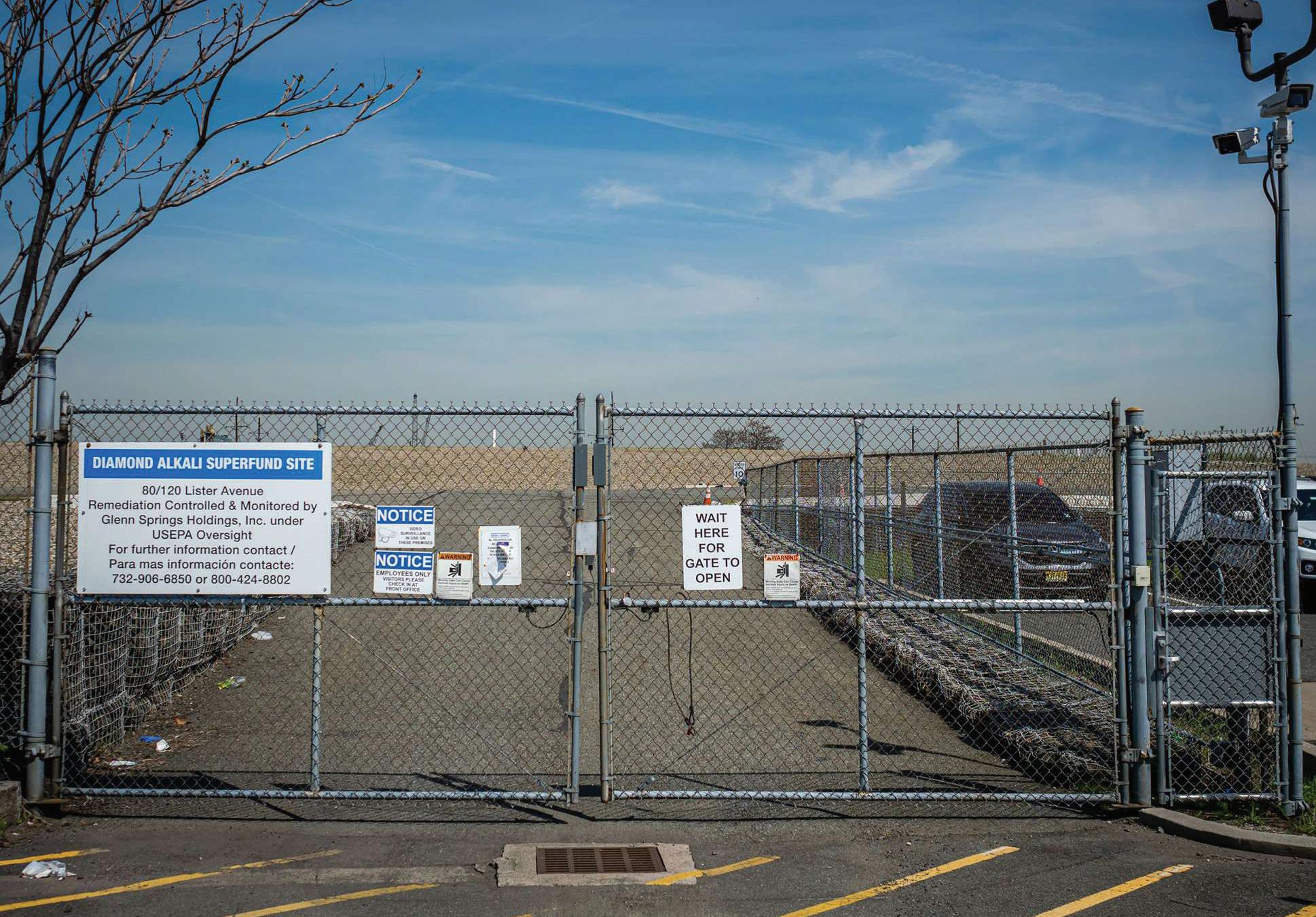
We consider ourselves frontline communities, communities that are impacted by climate crisis in a very quick and real way and at the negative receiving end of a lot of what the rest of the state might take for granted, like turning on a light bulb or flushing a toilet or throwing out garbage. We are not the only community that unfortunately has been targeted in this way. We know that a lot of communities throughout the country are experiencing the same thing. It’s why we have relationships with other environmental justice organizations throughout the country to think up strategies.
Inspiration to Stay the Course
The team that I work with has been a source of inspiration. We currently have less than 12 people and most of them are women, women of color or gender expansive people. Everyone on our team has grown up in environmental justice or frontline communities, so I really feel like all of us are invested in supporting one another and in how we continue this work.
The legacy of the community work before I came in is inspiring too. When that incinerator was proposed over 30 years ago, the people who were protesting it were community members who may still be involved with us now but are much older. When we do toxic tours of the community and show groups just how close residential life is to heavy industrial zoning and those legacy pieces of Superfund sites, we like to end at the park which was only made possible by protesting and organizing and community solidarity that happened decades before I was around, so they were able to save a park from demolition and push for a park to be built.
Community work has made it so that the Environmental Justice Law of New Jersey (S232) was passed, and that was beautiful to see. Over 300 people showed up to the New Jersey Department of Environmental Protection public hearing in Newark and shared over two hours of testimony, saying that the Environmental Justice Law is something that they support. And being able to defeat a sludge facility that wanted to come into our neighborhood last year, continued on page 11
AUTUMN 2023 9
All Are Welcome But…
By Melody Maravillas, Congregation Chief Financial Officer
In 2017, Hidden Figures hit theatres nationwide. The film is based on the true story of three AfricanAmerican women who were crucial to NASA’s efforts during the 1960s space race. In the movie, Katherine G. Johnson’s mathematical prowess lands her a spot as the first Black woman in an all-white, maledominated Space Task Group. When she walks into the room for the very first time, she is hesitant, nervous, and feeling very out-of-place. Katherine’s new boss sees her. Without taking any issue over her gender or race, he directs her to start working with the rest of the group.
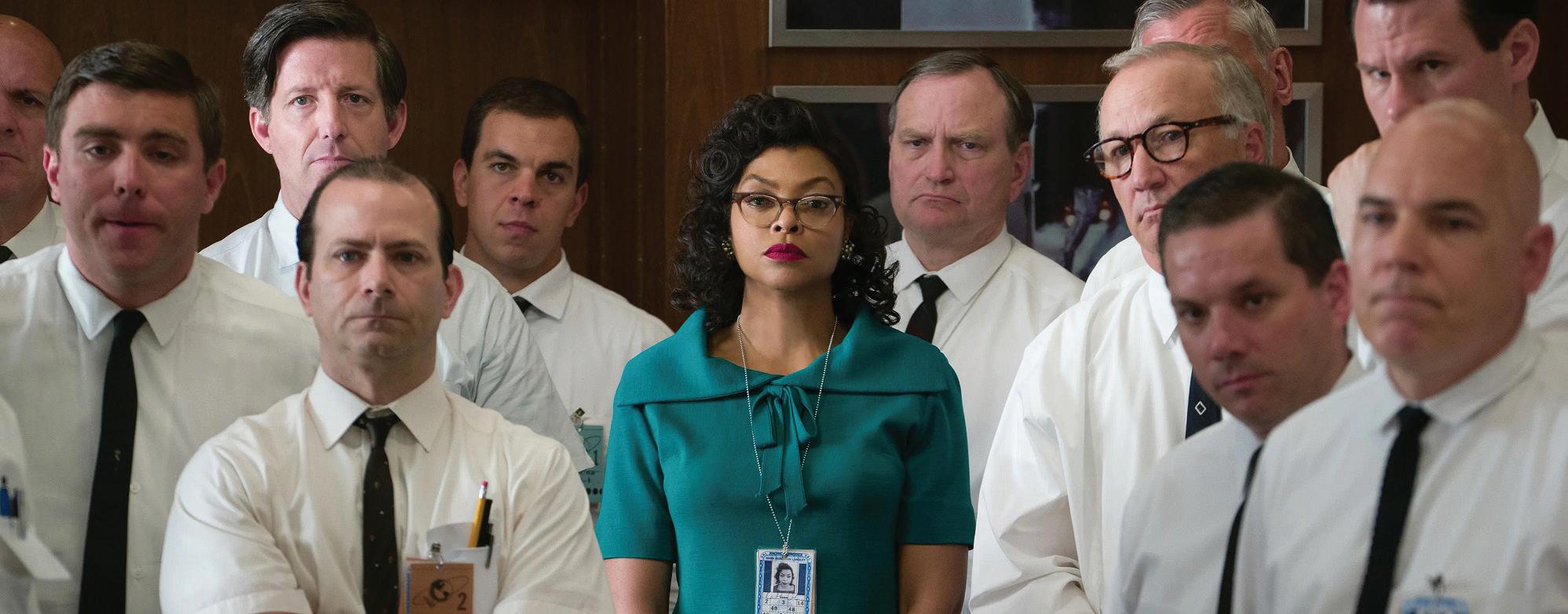
I remember watching that scene and thinking, “Finally, progress!” But it is very short-lived. When Katherine wants to get coffee, she sees the sign “Whites Only.” Subsequent scenes show her running half a mile to a different building multiple times just to use the “colored” bathroom. It isn’t until later in the film that her boss wakes up to Katherine’s reality and decides to do something about her troubles.
Sixty years later, despite the great strides society has made, our progress still feels half-baked. Just look at the news. Refugees are welcome, but they are bused to other states. Minorities are encouraged to start businesses, but they are considered too risky to invest in. Companies build diverse workforces but withhold key positions from women. Society is inclusive BUT… If there is something I learned about the word “but,” it is that everything you say before it does not matter.
When we want to be who we say we are, we want to live fully into our commitment without excuses, which entails removing the “but” that stops us from fully realizing the Congregation’s charism of peace through justice. We try to do that in several areas.
At home, we recognize that historically marginalized communities are still catching up from an educational or professional standpoint. As such, we review our job requirements so that we do not inadvertently screen out qualified people with limited backgrounds. Periodically, we analyze employee pay to ensure that they are free from gender or racial biases.
Beyond our walls, we continue to use our financial resources to build a society that listens to all voices and makes room for everyone at the table. Our charism gives us the courage to engage in difficult discussions with corporations, like the one we had with Citigroup, one of the world’s largest banks. We filed a shareholder resolution to advocate for indigenous people’s rights especially when it comes to projects that might encroach upon their lands. The Congregation also supported the International Rescue Committee’s Center for Economic Opportunity and Asylum Seeker Advocacy Project, who help newcomers settle into our communities. Through our financial support, these organizations provide low-cost loans to refugees and muchneeded legal assistance to asylum seekers. Going beyond our borders, we recently provided a grant continued top of page 11
10 LIVING PEACE
to Catholic Relief Services for women religious in Mexico and Guatemala, who are providing vulnerable children with safe and nurturing families. Being who we say we are also evokes a restlessness, a challenge if you will, to constantly assess ourselves for areas where we fall short. Recently, I participated in the Global Impact Investing Network’s (GIIN) program on Advancing Racial Equity. It was deep work that opened my eyes to business hurdles that minorities still have to overcome. For example, how “objective” criteria, such as longevity and performance track records, make it difficult for minority fund managers to gain access to investors. It’s like handing them the
Fresh Voices, continued from page 9
even before the Environmental Justice Law was fully implemented, those are things that I find motivating. This shows how a frontline community can be truly active in the policymaking process.
It feels like every week there’s something to celebrate and at the same time, we’re figuring out how next week we’ll be continuing in a different fight. So, while there are wins that I really appreciate being able to reference, I would say some anxiety exists around some of the current issues that we’re dealing with.
Our 30-plus-year-old garbage incinerator continues to have their permit renewed, they keep getting the okay to continue operating and this same incinerator has over 800 air permit violations on record. They have become very savvy on the kind of language that allows them to come across as using green technology. We consider that greenwashing: a way of telling people we’re just your friendly neighborhood waste management. Instead, they are burning garbage every single day by the tons into this neighborhood that already has the highest rate of asthma in the whole state.
The Environmental Justice Law very simply says that the Department of Environmental Protection has the power to now deny permits to new facilities that may contribute more pollution to communities that have already been overburdened by facilities and pollution, and that took over 12 years to get on the books. And only as of April did it get fully implemented.
How I Keep Balanced
It is interesting working in and enjoying the community that you also know is dealing with all these issues. But I always say that the only way that there has been over 30 years of people coming together to fight for it is because we love it so much, and I really, really love the city.
Monopoly card “Do Not Pass Go, Do Not Collect $200.” You can play with us on the same board BUT you don’t get the money. GIIN’s program brought CSJP together with other faith-based asset owners to see how we can break down these obstacles and work towards a more equitable distribution of wealth.
Building an inclusive society requires continuous action to look around us and see who else is not at the table. Otherwise, we run the risk of progress that is still half-baked. Had I been content with the work that we were already doing, I would not have known that there are more “buts” to eliminate.
One of the things I’m currently doing is, if possible, I’ll take a meeting on a walk. I’m at Branch Brook Park right now, which is closest to where I live, and it’s a gorgeous park. So, I think reconnecting to nature is this really great escape that I find is so pleasant. Nature gives me a lot of joy and peace and silence. It’s a sense of reciprocity that drives wanting to see our communities thrive, and so this is a way that I feel regenerated to keep going.
I have an older sister and an older brother. And my parents live only about 10 minutes from where I live, also within the city of Newark. And then in terms of the friendships that I have, I have friendships outside of work, but also people that tend to care about what’s going on in the community, or what’s going on in other social issues of the world. Connecting with people that I really love and care about also feels regenerating. When the work seems difficult, I think about a person that I care about, and I think about how pollution harms them and all of us in Newark and cities like ours. My teammates tend to also be friends, and we just check up on each other. We may have lunch together during the workday or work together at a café. It always does come back to a conversation about the work that we do, but we also really enjoy each other as people.
Our director Maria Lopez-Nuñez was appointed to the White House Environmental Justice Advisory Council. And that’s incredible because this is a person who has dedicated a large part of their life to the work that’s happening here in the Ironbound. I find that that’s also something that feels really motivating, that this is something that’s now being talked about at a national level. It makes me hopeful for what can happen with future initiatives.
AUTUMN 2023 11
The Refugee
I had a dream the other evening. In my dream, you were only seen by someone if they loved you; if you loved someone, you could see them.
In my dream, I had a brother who saw me but just barely because we had become so different and believed in different things. I still saw him clearly, but he made me angry when he couldn’t see me clearly. I decided to run away from him, so I could see him less clearly too. I ran over hills, valleys, plains, and he tried to follow me though he could barely see me. I looked behind and I could see him less and less. He still tried to follow but I ran faster. Soon he could not see me, and I never looked back to see him.
In my dream, I came to a large city and spent days moving around in it to find out what I could see. Finally, I saw a group of people I liked; I liked what they did, what they had, what they said. I went to live in their neighborhood, work in their offices, shop in their stores. But they never saw me. The only time they saw me was when they needed to be seen liking me, then when they were done, they saw me no more. Soon I started to see them less and less and I started to wander the city again.
In my dream, I came to an area filled with people like me, people looking to be seen and they could see me because we were the same. They did what they had to do, they had to make do with what they had, they were always kind and hopeful in their ways. At first it felt good to be seen by them, but I still wanted to be seen by those who did not see me. So slowly I started to see these people like me less and less. And I, in turn, was not seen by them very much either.
In my dream, I wondered: How could I ever be seen? My brother now could not see me, the city people did not see me, my own kind saw me less and less. And I saw less and less in turn.

In my dream, I could still see the sunrise and sunset, the moon and stars, the clouds, the trees, the plants, the mountains, all forms of life – all of creation. Seeing these things meant I loved these things. But unlike people, they couldn’t see me. Or could they? How could they?
 by Bryan Johns, CSJP-A
by Bryan Johns, CSJP-A

Someone must have made them in love. Someone must have made them see. So they could see me in that love and love me in turn. But why could I see them?
Someone must have made me in love. Someone must have made me see. So that I could see them in that love, and I love them in turn.
And I love the one who made the sunrise and sunset, the moon and stars, the clouds, the trees, the plants, the mountains, all forms of life because I could see that someone in them.
And I love the one who made me because I could see that someone in me.
So, shouldn’t I see my brother more clearly because someone also made him in love?
So, shouldn’t I see my own kind more clearly because someone also made them in love?
So, shouldn’t I see everyone more clearly, even those who refuse to see me, because someone also made them in love?
In my dream, I still wander. Yet now I know everyone sees me. And now I spend my days seeing them. Are you seen? Do you see?
12 LIVING PEACE
Watercolor by Julie Codd, CSJP
News from: Kenmare Press
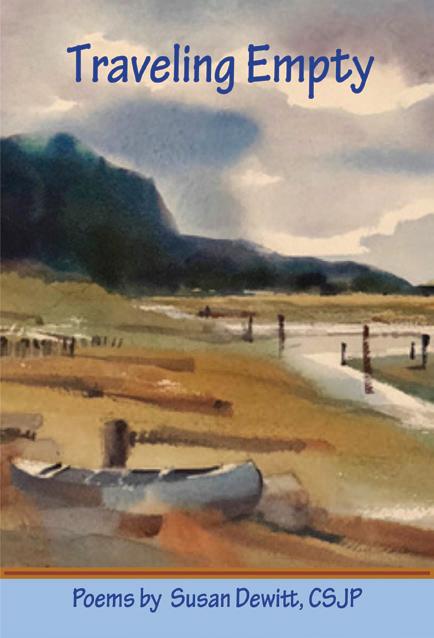
Just out from Kenmare Press, our latest book, Beyond All Galaxies: Poetry and Reflections for the Journey by Kathleen Pruitt, CSJP
There are now six books available under the Kenmare Press imprint in both paperback and eBook format. Find Kenmare Press on our website: https://bit.ly/kenmarepress

Peace Pays a Price by Dorothy Vidulich, CSJP
The Sparrow Finds Her Home: A Journey to Find the True Self by Doris J. Mical, CSJP
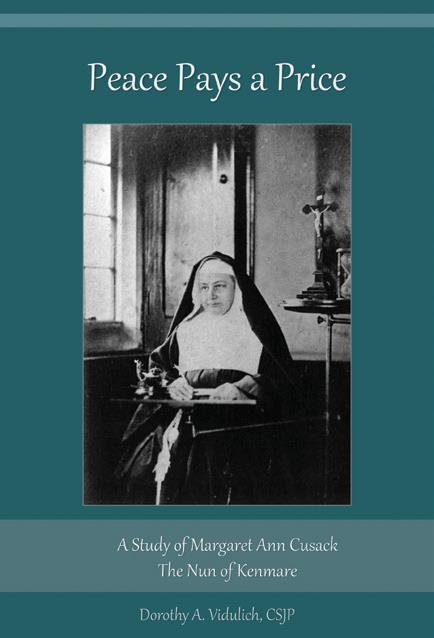
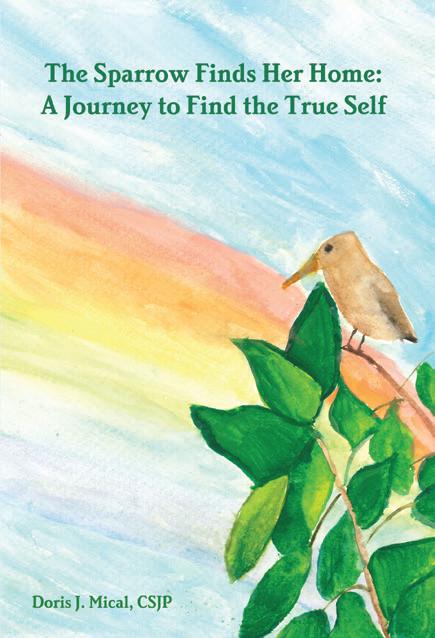
Traveling Empty – Poems by Susan Dewitt, CSJP
My Friend Joe: Reflections on St. Joseph by Susan Rose Francois, CSJP
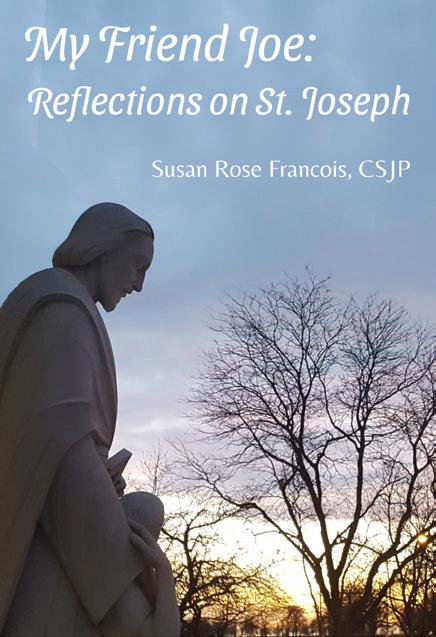
Images of Refuge by Margaret Jane Kling, CSJP
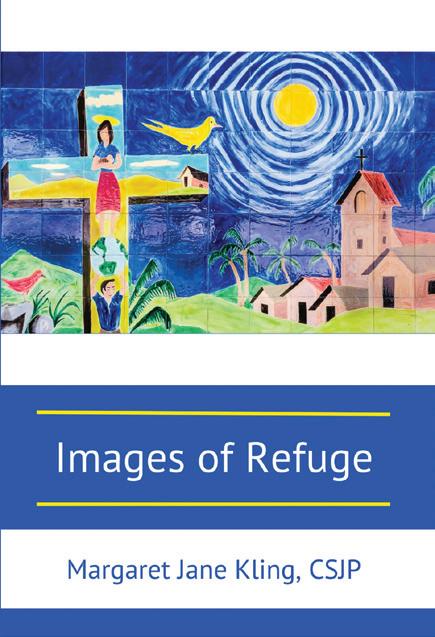
Beyond all Galaxies: Poetry and Reflections for the Journey by Kathleen Pruitt, CSJP
Kenmare Press is an imprint of the Sisters of St. Joseph of Peace and carries on the Congregation’s long tradition of writing and publishing. Our founder, Margaret Anna Cusack (Mother Francis Clare), was a prolific writer, most often publishing as M.F. Cusack or Mary Francis Cusack. By 1870, more than 200,000 copies of her works had circulated throughout the world. Profits from the sale of her books were used for the sisters’ work with the poor. Today, many of her books are in the public domain and available to read or download online.
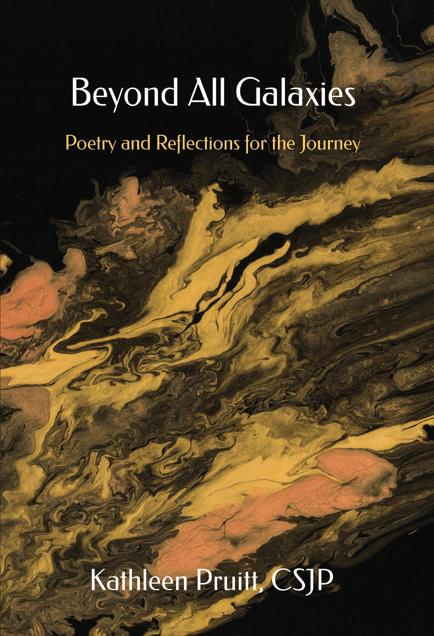
AUTUMN 2023 13
pause
Mindful

Every day I see or hear something that more or less kills me with delight, that leaves me like a needle in the haystack of light. It was what I was born for— to look, to listen, to lose myself inside this soft world— to instruct myself over and over in joy, and acclamation.
(Mary Oliver from Why I Wake Early: New Poems)
14 LIVING PEACE
Watercolor by Julie Codd, CSJP
The universe unfolds in God, who fills it completely. Hence, there is a mystical meaning to be found in a leaf, in a mountain trail, in a dewdrop, in a poor person’s face. The ideal is not only to pass from the exterior to the interior to discover the action of God in the soul, but also to discover God in all things. Saint Bonaventure teaches us that “contemplation deepens the more we feel the working of God’s grace within our hearts, and the better we learn to encounter God in creatures outside ourselves”.
(Pope Francis Laudato Si’, 233.)
I’m Going to Plant a Heart in the Earth
I’m going to plant a heart in the earth water it with love from a vein I’m going to praise it with the push of muscle and care for it in the sound of all dimensions. I’m going to leave a heart in the earth so it may grow and flower a heart that throbs with longing that adores everything green that will be strength and nourishment for birds that will be the sap of plants and mountains.
Prayer of Gratitude for the Earth
For the marvelous grace of your creation, we pour out our thanks to you God. For sun and moon and stars, for rain and dew and winds, for winter cold and summer heat. We praise you God for mountains and hills, for springs and valleys, for rivers and seas.
One does not need to fast for days and meditate for hours at a time to experience the sense of sublime mystery which constantly envelops us. All one needs to do is notice intelligently, if even for a brief moment, a blossoming tree, a forest flooded with autumn colors, an infant smiling.
(Simon Greenberg from A Jewish Philosophy and Pattern of Life)
We praise you God, for plants growing in earth and in water, for life inhabiting lakes and seas, for life creeping in soils and land, for creatures living in wetlands and waters, for lifeline flying above earth and sea, for beasts dwelling in woods and fields. How many and how wonderful are your works, O Lord.
(Peace Prayer inspired by and based on Season of Creation 2021 Irish Bishops’ Conference)
Special thanks to Sister Carmel Little for her preparation of the Weekly Peace Prayer, which can be found on the CSJP website under the Spirituality tab. And deep gratitude to Sister Julie Codd for the watercolors throughout this issue.
AUTUMN 2023 15
(Rosario Murillo; from Volcán : Poems from Central America, translated by Barbara Paschke)
FrankTalk Can We Grow in Awe and Wonder?
by Frank McCann, Congregation Peace through Justice Facilitator
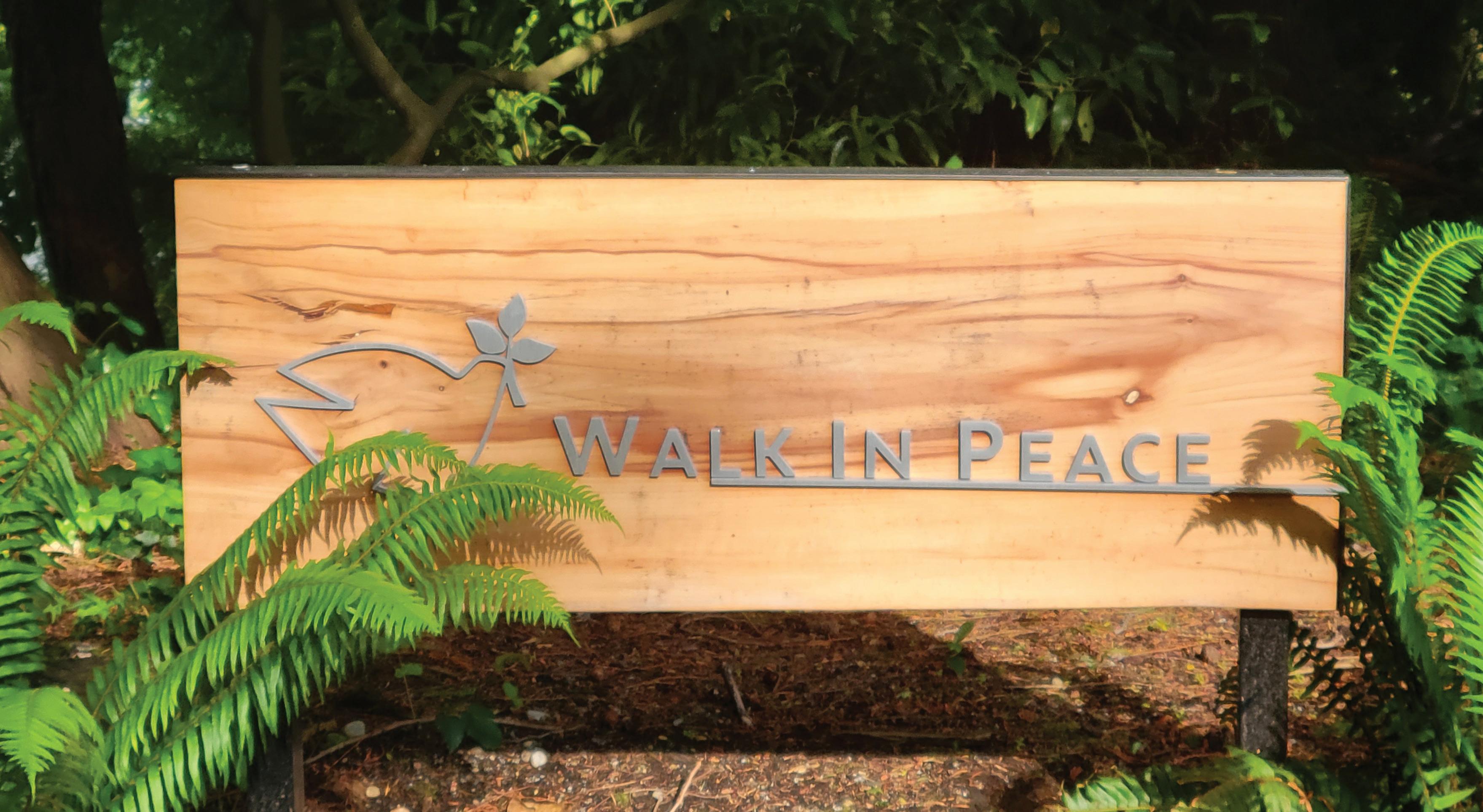
Becoming a Congregation that lives Pope Francis’ encyclical Laudato Si’ involves more than just turning off lights or taking shorter showers to conserve water. We are committing to a new consciousness concerning our relationships with Earth, our neighbors and fellow creatures. Doing so provides hope and a means for ending the extinction event we have initiated. Developing an ecological spirituality requires a profound personal transformation.
The need for a new consciousness is evident when Pope Francis writes of Sister Earth:
We have come to see ourselves as her lords and masters, entitled to plunder her at will. The violence present in our hearts, wounded by sin, is also reflected in the symptoms of sickness evident in the soil, in the water, in the air and all forms of life…
We have forgotten that we ourselves are dust of the earth (cf. Gen 2:7); our very bodies are made up of her elements, we breathe her air and we receive life and refreshment from her waters (Laudato Si’, 2).
Developing an ecological spirituality means opening ourselves again to the mysteries of life, to reverence each other and other life
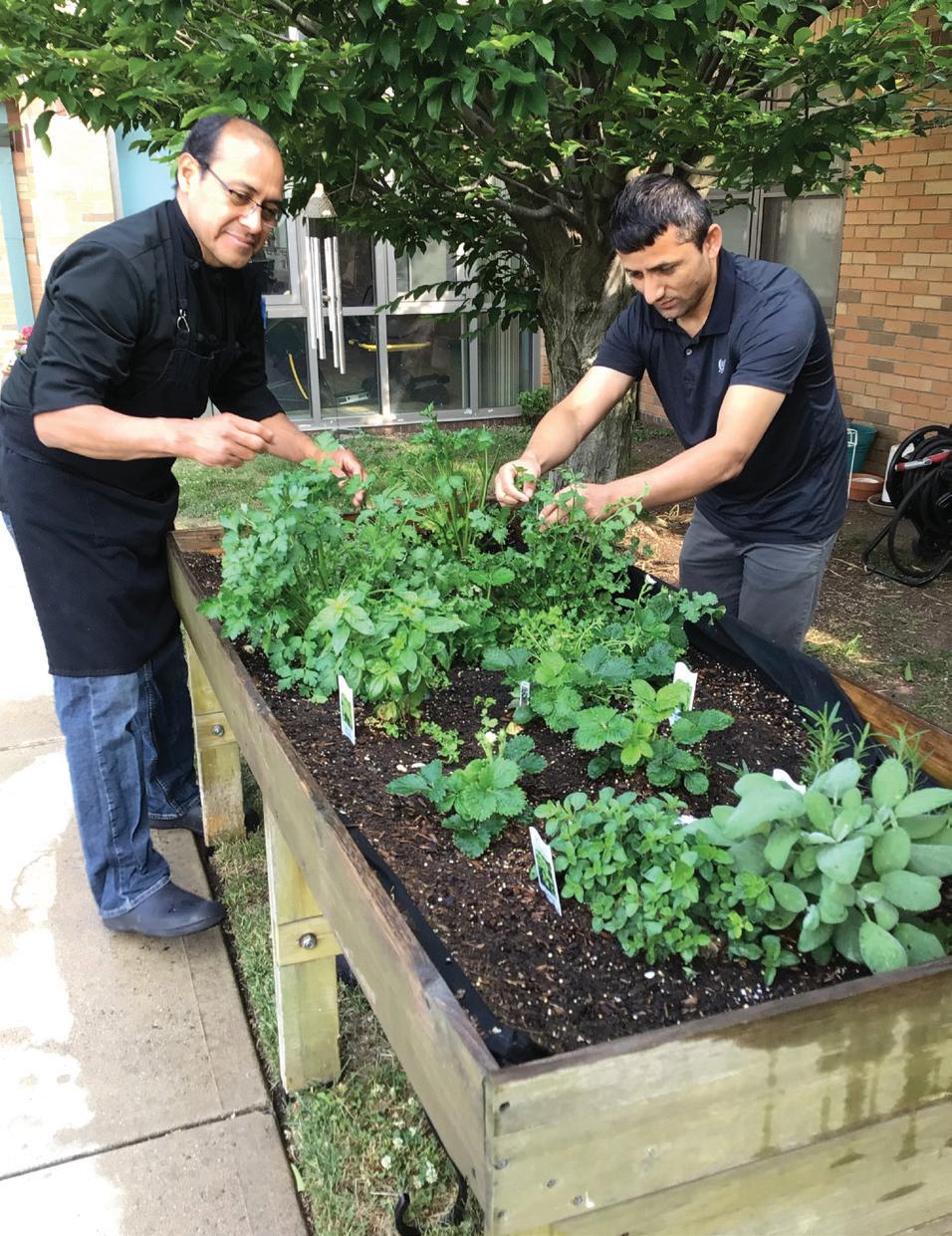
16 LIVING PEACE
Juan Gonzalez and Sabrudin Hakimi tend the garden at St. Michael Villa.
forms, regularly reflecting on the fact that we are all connected. Can we rediscover the numinous presence as we walk among the trees becoming more aware of the ongoing miracles that surround us? Can we grow in awe and wonder as we plant a flower garden? We should try. We need a corrective to the anthropocentric, technological voice that would use every resource on earth for more profit without a thought as to how that will bring life as we know it to an end.
Thomas Berry studied the religious traditions from around the world relating to creation. He also studied the science. From both faith and science, he came to understand “the universe is not a collection of objects but a communion of subjects.”
Our bodies are 55-60% water. Why do we stand for water being polluted by fertilizers and feces, or by oil and chemical waste from mining? How is it that water is treated as a commodity to be used to pay national debts, or to be bottled in plastic and sold? Is convenience so important to us that we will continue to use plastic which is poisoning our oceans and even entering our bloodstreams? Can we recover the sense of water as sacred to our lives, as the sustainer of life?
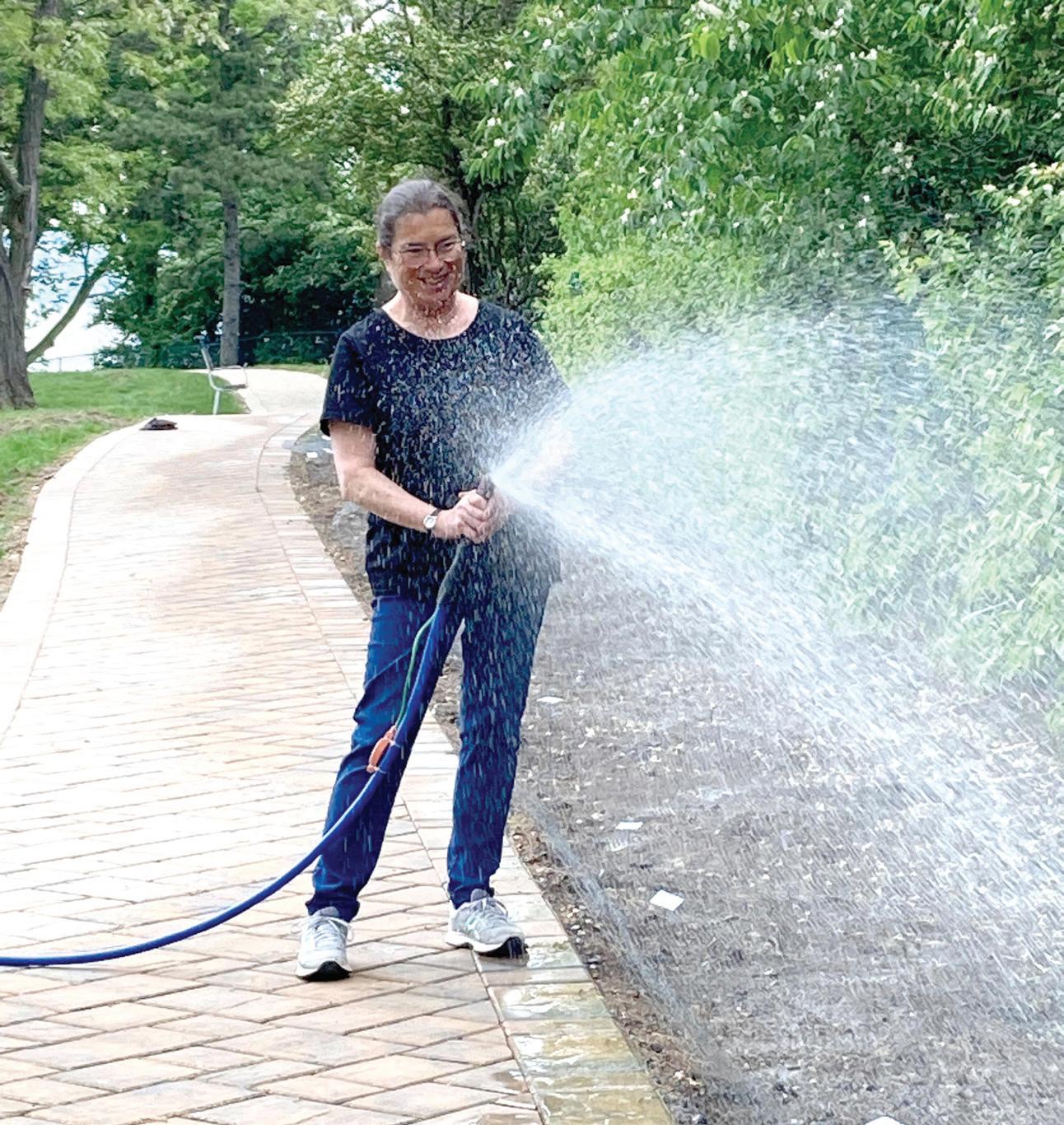
Recently, air in the United States was contaminated by smoke from climate-change-induced forest fires in Canada, blown down into our neighborhoods. Both countries have been burning fossil fuels. For some, the smoke crossing borders was a wakeup call to our interconnectedness, an example of how meaningless borders can be in an increasingly interconnected global community. For others, it was just another opportunity to blame another country.
nations around the globe looking for a new place to call home? What about the estimated 140 plant, animal and insect species that become extinct daily? What environment do we owe to our children and grandchildren?
To be who we say we are, we start with Jesus’ admonition to love our friends and our enemies (Mt. 5:44), to realize our neighbors are not just people who live near us (Lk. 10:25-37). We recognize we are part of creation, interconnected to all life. How can we proclaim to love God when we actively destroy the abundant and beautiful creation provided for us?
Look around and let the reality of what is happening to our common home sink in. Let our hearts be moved and our consciousness be changed. Let us read again the words of Pope Francis from his Laudato Si’ encyclical:
Are we not also connected to the polar bears in the northern regions, or to the people of Vanuatu in the South Pacific whose islands are being swallowed by rising seas, battered by cyclones, and threatened by earthquakes? These people have done nothing to cause climate disruption. What about our responsibilities to the millions of migrants, forced to flee their homes due to rising seas, drought, or flooding, who now sit at the borders of many
It must be said that some committed and prayerful Christians, with the excuse of realism and pragmatism, tend to ridicule expressions of concern for the environment. Others are passive; they choose not to change their habits and thus become inconsistent. So what they all need is an “ecological conversion”, whereby the effects of their encounter with Jesus Christ become evident in their relationship with the world around them. Living our vocation to be protectors of God’s handiwork is essential to a life of virtue; it is not an optional or secondary aspect of our Christian experience (LS, 217).
AUTUMN 2023 17
...the smoke crossing borders was a wake-up call to our interconnectedness, an example of how meaningless borders can be in an increasingly interconnected global community.
Mindy McDonald, CSJP waters the newly planted wildflower garden at St. Michael Villa.
Responding to the Signs of This Time
By Kelly Marsicano, Communications Coordinator
The Sisters of St. Joseph of Peace 2022 Chapter Call states: “These new times demand a change of heart: to be, think and act differently.” It is a recognition that we find ourselves in a place we have never been. In recent years we have experienced a global pandemic, an escalating climate crisis, a decline in institutions, and a global racial justice movement. Pope Francis has described this as “… not living in an era of change, but a change of era.” However, he said the Church should not be afraid of change and, instead, be “implanted and rooted in Christ, allowing to be led by the Spirit. Thus, everything will be possible with genius and creativity.”
With this change of era, we have a choice: to try to reclaim what was or to respond in new ways. I sat down with the executive director of Peace Ministries, Maureen Donohue, for further discussion.
Q: In many ways, Peace Ministries can be viewed as a direct response to this change of era. As sisters began to step away from active ministry roles, the Congregation formed Peace Ministries in 2014 to increase its ability to govern and advocate for their sponsored ministries. In what ways does Peace Ministries ensure the mission, core values and legacy of the Congregation continue?
A: Today, the sponsored ministries (Holy Name, Peace Care, St. Joseph’s School for the Blind, Waterspirit and York Street Project) are expressions of the Congregation’s mission, and whether they are providing education, healthcare services or social services, each ministry is rooted in the core values of the Congregation. A primary role of Peace Ministries is to foster understanding and deepen awareness of the Congregation’s core values in an ongoing way.
Peace Ministries articulates its mission through 11 goals and the first two capture the heart of our purpose. The first goal is to maintain individual ministry identity and mission while fostering a common grounding in the spirit and principles of the Sisters of St. Joseph of Peace, Catholic Social Teaching and Gospel values. The second goal is to work in partnership with the ministries to provide ongoing spiritual formation, leadership development, and mission integration for the board and staff of each ministry.
Peace Ministries was formed to assist the Congregation in carrying out this work through a variety of programs, aimed at strengthening relationships with the ministries and among the ministries themselves.
Q: Formation days are held annually for the Peace Ministries Board of Trustees. What is significant about these days and how are they helpful?
A: Formation has been a strong focus of Peace Ministries since the beginning. There was a recognition that the formation of trustees was essential for the board to carry out its sponsorship responsibilities in collaboration with the Congregation.
As stated in a recent article in Health Progress, “The role of formation is to create experiences that invite those who serve to discover connections between personal meaning and organization purpose.”
Each board meeting is structured to include an element of ongoing formation and prayer. We cover topics such as Catholic Social Teaching, the founding of the Congregation, the role of sponsors, principles of discernment, and much more.
The full-day sessions are held jointly with the Congregation Leadership Team and allow more time to go deeper with a given topic supplemented by prayer and reflection. These sessions strengthen the trustees’ sense of community and enable them to be a more effective board.
18 LIVING PEACE
Q: The most recent formation day was in February 2023, where Sister Mary Pellegrino, CSJ, senior vice president of Plante Moran REIA, presented on the topic of change of era. Guided by the 2007 article “Nostalgia and Its Discontents” by Svetlana Boym in The Hedgehog Review, Sister Mary talked about reflective nostalgia (recalling, storytelling) vs. restorative nostalgia (restoring the past and recreating the conditions). Looking toward the future, which do you feel is more fruitful and why?
A: I think reflective nostalgia is much more useful. It’s reflecting on something and recalling what we liked about it, how it made us feel. Such reflection can be both inspiring and motivating.
Restorative nostalgia longs to bring back the old ways, often in denial of what is different. There is an unwillingness to accept change, which creates an obstacle to true growth and responding to the now.
Q: Annual formation days are also held for the senior leaders and officers of the sponsored ministries. This year’s event, which will be held in October, will focus on the theme “Reading the Signs of the Times.” Why do you feel that particular topic is of such importance?
A: Reading the Signs of the Times is one of the eight core values of the Congregation. It was a mandate of Vatican II and a value that the Sisters of St. Joseph of Peace have embraced throughout their history. In light of this change of era that Pope Francis speaks about, we thought it particularly timely to focus on this core value with our ministry leaders. We know they are experiencing the implications of change on such a large scale and seeking to respond in new
ways that they might not have envisioned even two or three years ago.
This time we find ourselves in is so markedly different that our formation day gives us the opportunity to ask the question: What is this moment demanding of us differently than in the past? Our hope is that the attendees will be able to step back and gain new insights into how best to lead during this time of massive change and disruption.
Q: In Peace Ministries’ strategic plan, there are objectives that reflect the signs of the times, particularly on formation and orientation. How do these components benefit the ministries and those they serve?
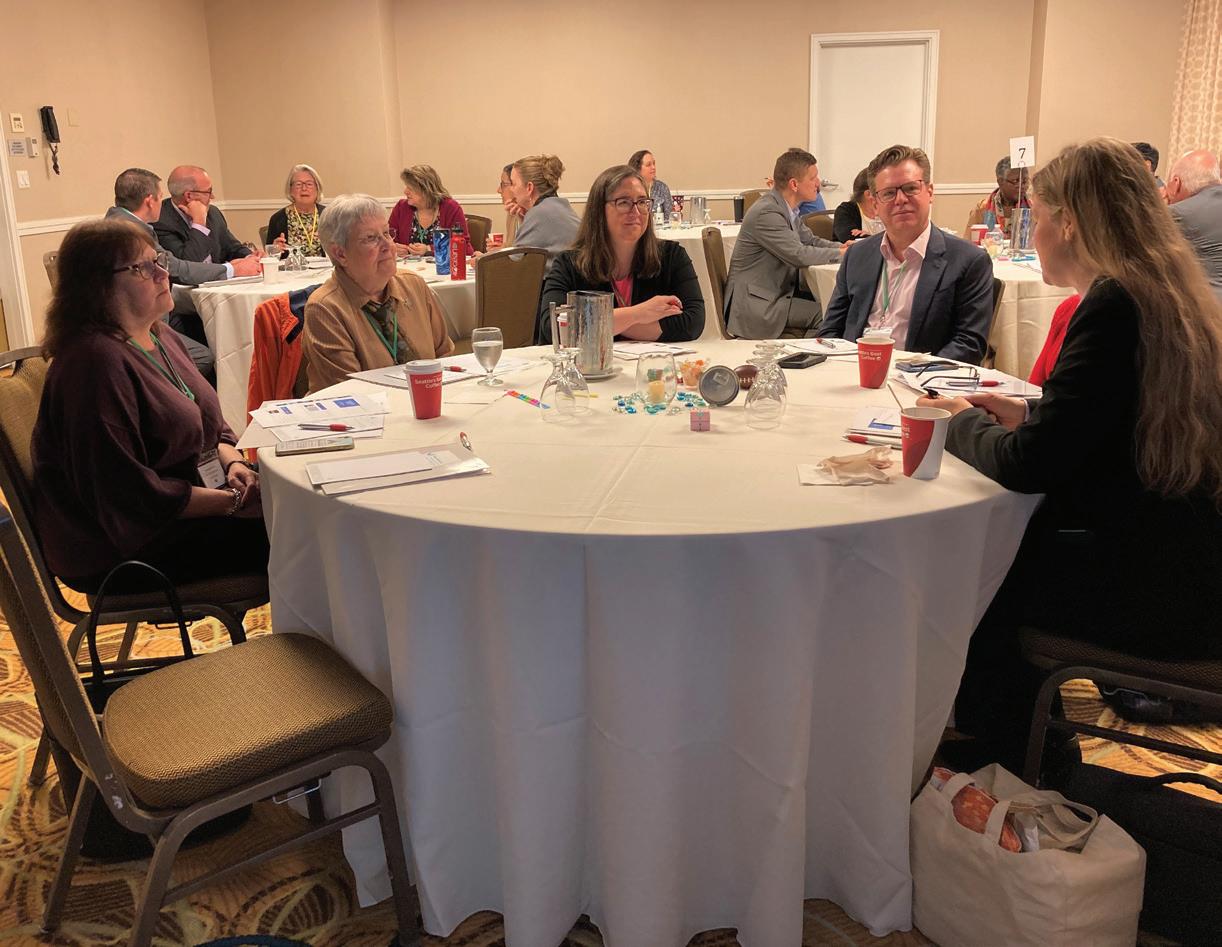
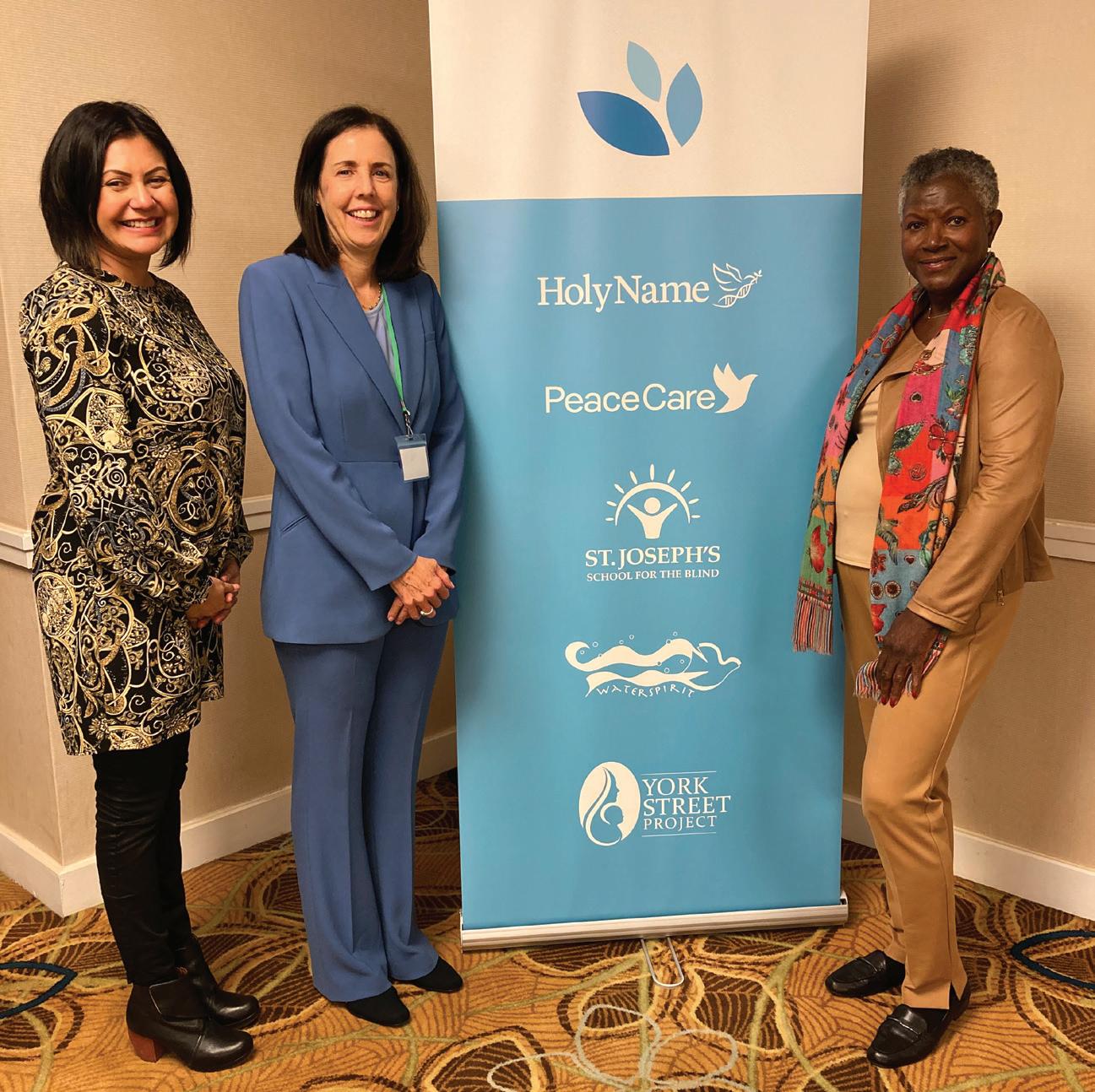
A: Since one of our key purposes is to foster that common grounding in the charism of the Sisters of St. Joseph of Peace and Gospel values, the plan addresses how we can strengthen the resources provided to ministries to educate and orient their employees and leaders. Recent efforts have resulted in an inventory of orientation resources, which we will continue to update with the feedback of our ministries to ensure they remain helpful and relevant.
Another critical area is the mission review process called Mission Alive. Developed by Peace Ministries several years ago, the process is being implemented in each ministry. This is a formational program that invites ministries to reflect on their mission through the lens of specific core values to deepen their connection to the ministry’s mission and explore ways to strengthen particular core values within their ministry.
continued on page 21
AUTUMN 2023 19 19 LIVING PEACE
Above: Senior leaders and board members engage in conversation during the 2022 Fall Formation.
Right: Dr. Erica Torres, presenter at the 2022 Fall Formation, stands with Maureen Donohue, executive director of Peace Ministries, and Arleatha Williams, Peace Ministries board chair.
Just Work
By Stephanie Peirolo, CSJP-A
I work as an executive coach and consultant for companies that are in the business of making money. I got into this work because I wanted to improve a system that I thought was broken. I wanted to help leaders be more skillful and create more supportive work environments, especially for underrepresented minorities. But recently I’ve come to believe that the system isn’t broken. It is working effectively as designed to make owners and shareholders richer at the cost of the people who actually do the work. And this is causing me to have a change of heart in my understanding of how I want to participate in this system.
We talk about just war, war that is morally justifiable. While people don’t agree on what, specifically, a just war is, most of us agree that war is bad, and we should never enter into it lightly. Some argue that war is justifiable in the case of, for example, Nazi Germany, as they engineered the Holocaust. What about just work? What if we started to look at the state of work in this country through a social justice lens? Not just from the systemic perspective but also from the individual perspective. How do I want to work? What companies will I support and why?
Work in and of itself is good. I always say that children and dogs are happier if they have a job to do, and I think adults are the same. But work that disregards the humanity and dignity of the people doing the work is wrong.
Too many corporations talk about work life balance as “nice to have.” It’s more aspirational than actual. Paid time off for illness, paid parental leave, and longer maternity leave aren’t just benefits for the individual worker; they are beneficial for the entire community and society.

The American healthcare system is unique in that health care coverage is connected to employment. For many, their job provides their health insurance, which gives employers too much power. The layoffs that ripped through the technology sector in the last year are going to be especially hard for families with members who are chronically ill. Ask any parent with a child with a chronic illness or disability how much they pay out of pocket to keep their child alive, and you’ll be shocked.
I have regularly worked 60-hour weeks and days on end of 12-hour days. I grew up thinking that if I worked harder, I would be safe at work, which to a certain degree was true – if you do the work of three people, you are less likely to be laid off. The individualistic approach to this is typical of capitalism. The story that I am responsible for my own safety and security is a key part of the problem. When I talk with friends who work in union shops, I am always surprised at the efficacy of the collective – they are safe because they are in a group that keeps them safe. Why did I think I always had to do it on my own?
Amazon has terrible working conditions for their warehouse workers, with injury rates 70% higher than
20 LIVING PEACE
other similar warehouse companies and twice that of the competition. And yet, since I started writing this, I have mindlessly clicked multiple times on the Amazon app to get something delivered quickly from a warehouse that doesn’t consider the safety of their workers a priority. Why don’t I consider privileging my convenience at the cost of others a problem?
Organizations that work hard against union organizations are also unjust. According to an article from this April in Fast Company, “the National Labor Relations Board has issued more than 80 complaints against Starbucks for labor law violations; those violations include denying pay and benefits to unionized workers and illegally firing workers involved in the union.” But how many of us still go to non-union Starbucks and buy our favorite caffeinated treat?
Finally, we need to fundamentally reframe the narratives we have around careers, for ourselves and our children. My father was very successful. Until he got sick with a rare heart disease. He died in his forties. I wish he’d spent less time at work and more time with me and my sister. My son died when he was nineteen. I wish I’d spent less time at work and more time with him and my daughter.
Recently, my four-year-old granddaughter, Ruby, spent the night with us. We watched an old G-rated movie about a mouse detective. Like Sherlock Holmes, the mouse wore a deerstalker hat and smoked a Meerschaum pipe. Ruby kept asking about the pipe. I realized she’s never seen anyone smoke. She watches mostly Sesame Street and Curious George, and no one in her family smokes.
I tried to explain it to her, but she couldn’t quite understand why anyone would put something in their mouth and set it on fire. Fire is dangerous, right? “Does it hurt?” she asked me, her brows pulled together in concern.
That’s a generational change. She is growing up in a time and place where fewer people smoke, and there are fewer depictions of smoking in media.
I hope that by the time she has children, we will have gone through a similar cultural change in how we work. And that some older person will be explaining to a child watching an old movie that people used to work long hours and bragged about sleeping at their offices. That people had to go to work sick, and very soon after they gave birth; that individuals had to work long hours and they still risked being laid off with no notice and losing their health insurance. And the child will look at the older person with the same mystification. “Didn’t that hurt?”
Responding to the Signs, continued from page 19
The Mission Alive process involves data collection and discussion among ministry employees to assess and enhance their understanding of the mission. For example, through St. Joseph’s School for the Blind’s recent process, they focused on collaboration and respect for human dignity, which led to the first-ever employee wellness committee with a focus on social, physical, mental and financial well-being.
Q: The strategic plan also focuses on recruitment, including a commitment to diversifying boards and making room at the table. Can you explain why this is so crucial?
A: Peace Ministries and each of the sponsored ministries rely on the generosity and talents of volunteers who serve on our governing boards. To respond to the signs of the times and support our ministries into the future, we need to ensure that these boards reflect the diversity of our communities and those we serve. When I say diverse, I mean it in the broadest sense of the word—age, race, ethnicity, gender, expertise, faith and perspective. We want to cultivate board tables where each person feels included, welcomed and where their gifts are honored. It is that diversity of thought and perspective that will make for stronger governing boards, better able to lead our ministries into the future.
Q: In conclusion, is there anything you would like to add?
A: The Congregation Leadership Team and Peace Ministries continue to grow in the understanding of our shared ministry of sponsorship. We continue to ask ourselves what this time requires of us and what the ministries most need from us to support their viability while retaining the legacy and values of the Sisters of St. Joseph of Peace.
At our recent formation day, Sister Mary spoke with us about legacy as a blend of continuity and innovation. She said one can speak of vision in the same way. A vision for the future carries the essentials of the past forward and innovates them for the needs of the day. Rooted in the Congregation’s mission to make Christ’s gospel of peace come alive through works of justice, may we be courageous in following the promptings of the Spirit as we respond to the signs of this time.
AUTUMN 2023 21
Our Lady Chapel in St Barnabas Cathedral
History&Roots Stick to Your Colours
by Susan Francois, CSJP
In our Congregation archives, we have the final advice of Mother Evangelista (Honoria Gaffney) to the assembled community of sisters in Nottingham from her deathbed, as recorded by Sister Ignatius Killian: “Stick to your colours. Uphold the simplicity, unity, and family spirit that have always animated and been the distinctive character of our Community. Mother Clare taught it to us. Mother Teresa Kiernan received it and taught it. I in my poor way have done my best to uphold it. Trust and have confidence in one another, as the spouses and dear children of Jesus Christ. Be kind to one another.”
These words ring true to her lived experience as a Sister of St. Joseph of Peace, from the beginning of her vocational call to her very last breath.
As one of the first sisters to profess vows, who just four years later was thrust into a leadership position as the first Superior General, Mother Evangelista experienced firsthand the challenging early years of the Congregation. She described these times in response to the questions of Bishop Dunn of Nottingham, a few months before her death: “We have had poverty, humiliations, trials, difficulties, disappointments, failures, etc. but never a moments’ regret for having entered religion with Rev. Mother Clare.” From the perspective of history, her instincts and experience seem to have helped her to know and teach that, when faced with times of struggle and uncertainty, the mission of peace is best served by simply being who we say we are.
Although Mother Evangelista did not leave a vast written repository like her companion Mother Clare, her few written reflections and letters found in our archives paint a picture of a deeply spiritual woman rooted in the love and peace of God. As a thirty-yearold teacher discerning a religious vocation, she was struck “very forcibly” by a remark of a Dominican Father while on retreat: “If you give your heart to God don’t divide it.” Unity and a desire for an undivided heart guided her way of being, thinking, and acting throughout her life, and especially in her ministry of leadership. (The Undivided Heart is the title of the 1958 biography of Mother Evangelista by Sister Rosarrii McDermott.)
As formation director, she encouraged the sisters to “aim at striking deep roots” early in their religious life, going so far as to take the postulants to the potting house for a practical demonstration, where the gardener had sown seedlings. Sister Stanislaus, one of the postulants, later reflected that in time “good sturdy plants appeared—a good lesson and an inspiring one at the beginning of one’s postulancy.”
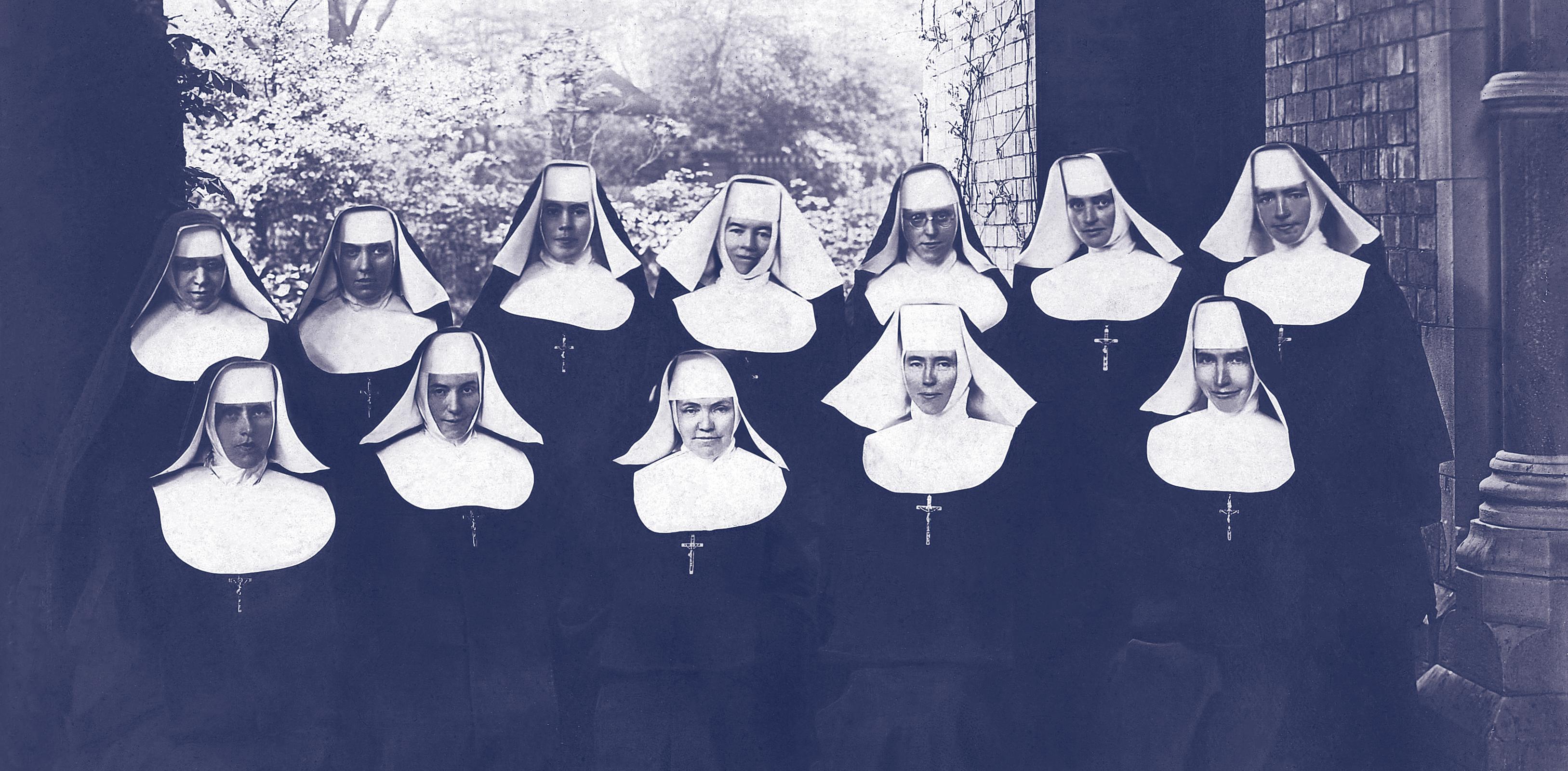
One of Evangelista’s novices, Sister Loyola, remembered her “outstanding virtues—humility and love of God in the person of all those she met each day, an abiding knowledge of the Presence of God.”
Not only did Mother Evangelista plant seeds of peace in the young women she guided on their discernment journey, the retreat notes that she left us also clearly demonstrate her commitment to nourishing her own
22 LIVING PEACE
Back row, left to right: Helena, Unidentified Sister, Gertrude, Vincent, Berchmans, Stanislaus, Teresa
Front row, left to right: Regis, Stephen, Mother Evangelista, Clotilda, Anthony
deep roots through prayer and regular retreats. In her notes, she often reflected on the presence of God. “Empty yourself of yourself, and you will find God. God and me and Jesus. God is all.” These roots enabled Mother Evangelista to resist division and negative forces by holding fast to her belief in the abiding presence of a God who calls us to unity.
In 1896, just over a decade after our founding, and several years after the tumultuous departure of Mother Clare in 1888, the Congregation counted 71 members in three separate dioceses across a vast geographic spread: 22 in the Diocese of Nottingham, 8 in the Nisqually Diocese (now Seattle), and 41 in the Diocese of Newark. Looking back from the perspective of our era of digital communication and global travel, it is hard to imagine how Mother Evangelista and her leadership council fostered unity and connection across the miles.
Nevertheless, she firmly believed in the family spirit and unity of the Congregation, even when pressured by Bishop Wigger of Newark to divide the Congregation in the United States from that in England. The Bishop had refused to approve the profession of vows of sisters in his diocese until the matter was resolved. This understandably caused Mother Evangelista much anxiety.
With the support of Bishop Bagshawe of Nottingham, Mother Evangelista wrote to Rome: “We feel convinced that to sever this connection would be to the detriment of the communities on both sides and would only destroy the spirit of unity and harmony which exists throughout. … All I seek is to protect the interests of our Institute by keeping them as one body and one head for the accomplishment of the greater good.” Her letter makes a clear argument and plea for the support of the Sacred Congregation. “If one separation takes place another will most likely follow.” True to her oft quoted adage to the sisters to “be kind to God’s priests and God’s poor,” she also makes a distinct effort to be respectful of Bishop Wigger in the letter to Rome. “The Rt. Rev. Bishop of Newark has largely contributed to the success which has attended the works of our Sisters in America and we owe in return a lifelong debt of gratitude.” In other words, even in the face of the possible destruction of the community, she stuck to our colours and acted as a woman of peace.
Thankfully, the Sacred Congregation in Rome sided with Mother Evangelista and Bishop Bagshawe. We remained then, as we are today, one Congregation united in our diversity across three distinct geographic regions.
We invite you to connect & participate
Consider becoming a Sister
In the USA contact: Sister Chero Chuma, CSJP, US Vocation Director, cherochuma@csjp.org
In the UK, contact: Sister Maureen Brennan, CSJP, UK Vocation Director, maureenbrennancsjp@gmail.com
Consider becoming an associate
Women or men who share our concerns and charism, visit: https://csjp.org/join-us
request prayer Support
Do not be anxious about anything, but in everything, by prayer and supplication, with thanksgiving, let your requests be made known to God.
—Philippians 4:6
Our sisters and associates pray daily for friends, supporters, all who ask our prayers and those linked with us through the Pious Union of Prayer. The original purpose of this Union was to form a network of prayer for peace in homes and in families. Send a request online by selecting “Prayer Request” from our website home page menu, www.csjp.org or by mail in the U.S. using the return envelope.
Subscriptions/Feedback
We invite you to subscribe to Living Peace at no cost. Subscribe online by selecting About Us/ Publications and Media from our website homepage menu.
learn more about us at csjp.org AUTUMN 2023 23
399 Hudson Terrace
Englewood Cliffs, NJ 07632
We find ourselves at a place we’ve never been, at the edge of tomorrow, the dawn of our reCreation. These new times demand a change of heart: to be, think, and act differently. Our spiritual lives require deep re-examination and transformation; our outward actions must confront privilege and power in ourselves and society.
It is time to be who we have always said we are. It is time to live our words. We embrace these promptings of the Spirit with courage, humility, hope and trust.
(Adapted from the Sisters of St. Joseph of Peace 2023 Chapter Call – To Be Who We Say We Are)
Sisters of St. Joseph of Peace
Congregation Office
Pursuing justice, we seek God’s gift of peace.




 by Andrea Nenzel, CSJP
by Andrea Nenzel, CSJP







 by Bryan Johns, CSJP-A
by Bryan Johns, CSJP-A















